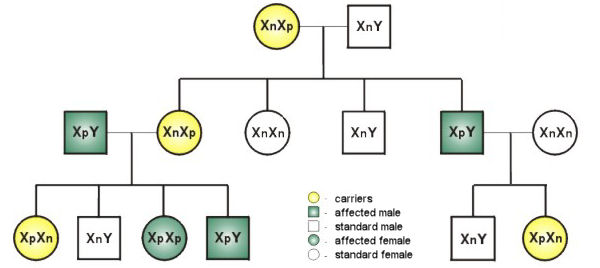
Pedigree for colour deficiency
The pedigree is
typical for an X-linked recessive trait. The parents in the first generation
both have standard vision; the mother
(circle) is heterozygous with two
alleles, n and p.
Four combinations of gender and colour-deficiency are possible in their
children, and are expected with equal frequency: carrier (heterozygous)
daughters with standard vision, standard daughters, standard sons, and
affected sons.
If the first-born daughter is a carrier and marries a colour-deficient husband, they in turn can expect four types of offspring at equal frequencies: carrier daughters, standard sons, affected daughters, and affected sons. In the family on the far right, the last-born colour-deficient son marries a woman with standard vision, and only two types of children can result: standard sons and carrier daughters. Note that, in this family unlike the previous, colour-deficiency will "skip" a generation, and may appear in the next generation in the sons of the carrier daughters.
Note that the birth of an affected woman requires an unusual combination of circumstances. Only about 10% of men are affected, only about 18% of women are carriers, thus only 1.8% of marriages are at risk, and only half of their daughters will be a homozygous recessive: 0.10 x 0.18 x 0.5 = 0.9% of daughters will be so affected.
[For the advanced student: if f(p) = 0.1, then f(n) = 1 - 0.1, and f(np) = (2)(0.1)(0.9) = 0.18, and (0.5 )(0.18) =0.09]
If the first-born daughter is a carrier and marries a colour-deficient husband, they in turn can expect four types of offspring at equal frequencies: carrier daughters, standard sons, affected daughters, and affected sons. In the family on the far right, the last-born colour-deficient son marries a woman with standard vision, and only two types of children can result: standard sons and carrier daughters. Note that, in this family unlike the previous, colour-deficiency will "skip" a generation, and may appear in the next generation in the sons of the carrier daughters.
Note that the birth of an affected woman requires an unusual combination of circumstances. Only about 10% of men are affected, only about 18% of women are carriers, thus only 1.8% of marriages are at risk, and only half of their daughters will be a homozygous recessive: 0.10 x 0.18 x 0.5 = 0.9% of daughters will be so affected.
[For the advanced student: if f(p) = 0.1, then f(n) = 1 - 0.1, and f(np) = (2)(0.1)(0.9) = 0.18, and (0.5 )(0.18) =0.09]